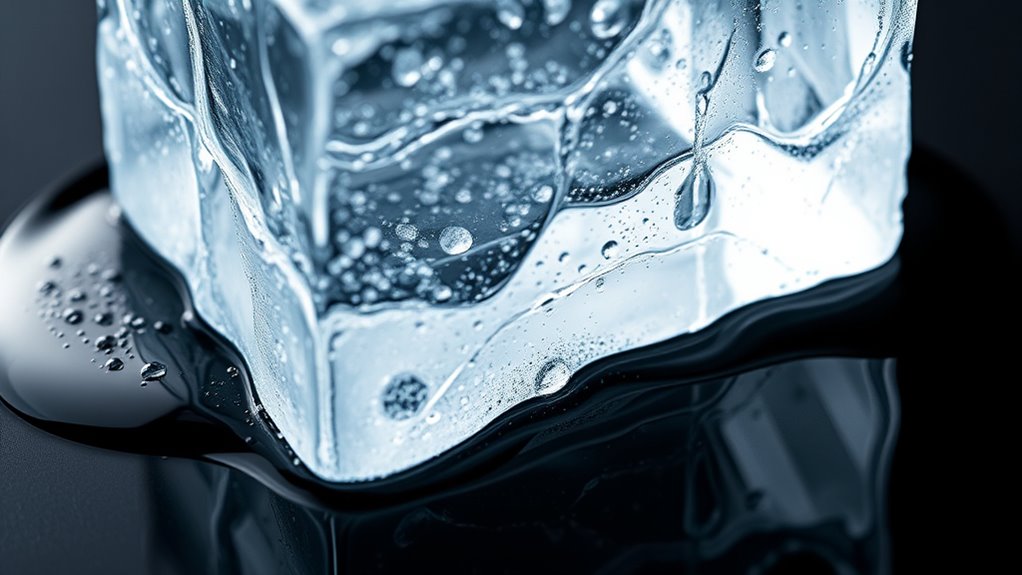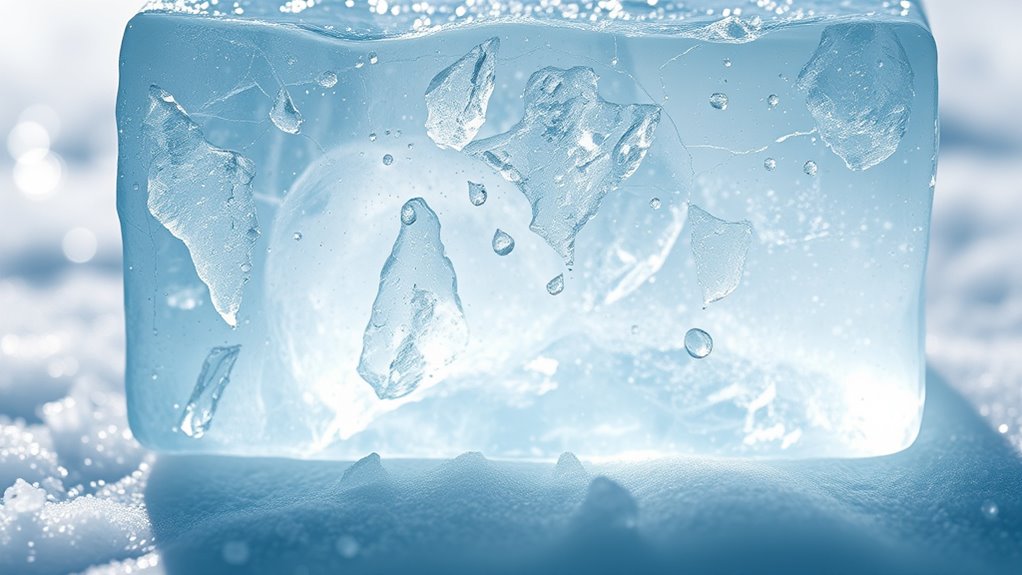The science of ice shows how water molecules change during melting and freezing. When you heat ice, hydrogen bonds break, allowing molecules to move freely and turn into liquid water at 0°C under normal conditions. Freezing occurs when molecules slow down and form a stable hexagonal crystalline structure. External factors like pressure and impurities influence these processes. If you want to understand the fascinating specifics behind these phase changes, there’s more to discover ahead.
Key Takeaways
- Ice forms through the organization of water molecules into a crystalline hexagonal lattice during freezing.
- Freezing releases latent heat, maintaining a constant temperature until the entire water sample solidifies.
- Melting occurs when heat energy breaks hydrogen bonds, allowing molecules to transition back to liquid form at 0°C.
- Impurities and pressure can alter the melting and freezing points of water, affecting ice stability.
- Molecular interactions, such as hydrogen bonding, govern phase changes and influence ice’s behavior in natural and environmental processes.

Have you ever wondered what makes ice so unique? It all comes down to its molecular structure and how it changes during phase transitions. When water freezes into ice, the molecules arrange themselves into a specific pattern, forming a crystalline lattice that’s both orderly and stable. This pattern results from the way each water molecule, made up of two hydrogen atoms and one oxygen atom, bonds with its neighbors through hydrogen bonds. These bonds create a rigid, hexagonal structure that’s less dense than liquid water, which is why ice floats. Understanding this molecular structure is key to grasping how ice behaves under different conditions.
As temperature drops, water undergoes phase transitions, shifting from liquid to solid. When heat is removed, water molecules lose energy and slow down. Eventually, they reach a point where they can no longer move freely and start to settle into fixed positions, forming ice. This transformation from liquid to solid is a pivotal phase transition that involves a significant reorganization of molecules. During this process, the molecules lock into their crystalline structure, releasing a small amount of energy called latent heat. This release helps maintain a constant temperature during freezing, creating the familiar process you observe when water turns into ice. This process is also influenced by environmental factors like pressure and impurities, which can modify the freezing point.
The phase transition from ice to water, or melting, is just as fascinating. When heat is applied, the molecules gain energy and vibrate more vigorously. Once they reach a critical point, the hydrogen bonds holding the crystalline structure together break apart, allowing the molecules to move more freely again. This melting process is also a phase transition, where the ordered structure dissolves into the more chaotic arrangement of liquid water. Interestingly, this transition can occur at a specific temperature known as the melting point, which is 0°C (32°F) under standard atmospheric pressure. However, impurities or pressure changes can alter this melting temperature, demonstrating how sensitive phase transitions are to environmental conditions.
Throughout these phase changes, the molecular structure of ice plays a vital role. The transition involves rearranging molecules without changing their fundamental composition. This is why ice can repeatedly melt and refreeze, undergoing phase transitions without losing its identity. The stability of the crystalline structure during freezing and the energy exchange during melting are direct results of how water molecules interact through hydrogen bonds. By understanding the molecular structure and phase transitions of ice, you gain insight into not just how it changes state, but also how it influences everything from weather patterns to climate change, and even the preservation of biological materials in cold environments.
Frequently Asked Questions
How Does Impurities Affect Ice Melting and Freezing Points?
Impurity effects lower the melting point of ice, meaning it melts at a temperature below 0°C. When you add impurities like salt or other substances, they disrupt the orderly ice structure, making it easier for the ice to melt. This is why salt is used on roads in winter. The impurities prevent the ice molecules from bonding tightly, which directly affects the melting and freezing points, making ice melt faster or freeze at lower temperatures.
Can Ice Exist in a Supercooled State? if Yes, How?
Yes, ice can exist in a supercooled state. You can achieve this through supercooling phenomena by cooling pure water below its freezing point without it turning into ice. Nucleation control plays a key role here; by preventing impurities and disturbances, you stop ice crystals from forming. This way, the water remains liquid despite being colder than 0°C, until an impulse triggers rapid crystallization.
What Role Does Pressure Play in Ice Phase Transitions?
Did you know that increasing pressure can lower ice’s melting point from 0°C to as low as -22°C? Pressure effects are vital in ice phase transitions; they cause ice to change from one form to another, like from Ice I to Ice II or III. When pressure increases, it forces molecules closer together, triggering these phase transitions. So, pressure directly influences how and when ice melts or crystallizes.
How Do Different Types of Ice Crystals Form in Nature?
You see different types of ice crystals form through crystal nucleation, which begins when water vapor or liquid water cools and molecules arrange themselves into structured patterns. In nature, frost formation occurs when water vapor directly deposits onto surfaces, creating intricate ice crystals. Variations in temperature, humidity, and surface imperfections influence whether you get hexagonal snowflakes or needle-like frost crystals, each shaped by specific environmental conditions.
Are There Artificial Methods to Control Ice Melting Outdoors?
Controlling ice melting outdoors is like turning a faucet on or off. You can use artificial cooling systems, such as portable chillers or spray cooling, to lower temperatures directly. Surface insulation, like foam or reflective covers, helps prevent heat transfer and slows melting. These methods work together to manage ice stability, especially in construction sites or for outdoor events, giving you more control over melting processes.
Conclusion
So, stay curious and keep exploring the fascinating facets of freeze and melt. Remember, the science of ice isn’t just about cold; it’s about understanding the delicate dance of molecules, the marvels of matter, and the mysteries that melt and freeze. By observing, questioning, and learning, you’ll unseal the secrets of this chilling charm. Embrace the excitement, energize your enthusiasm, and let the science of ice inspire your endless exploration!








